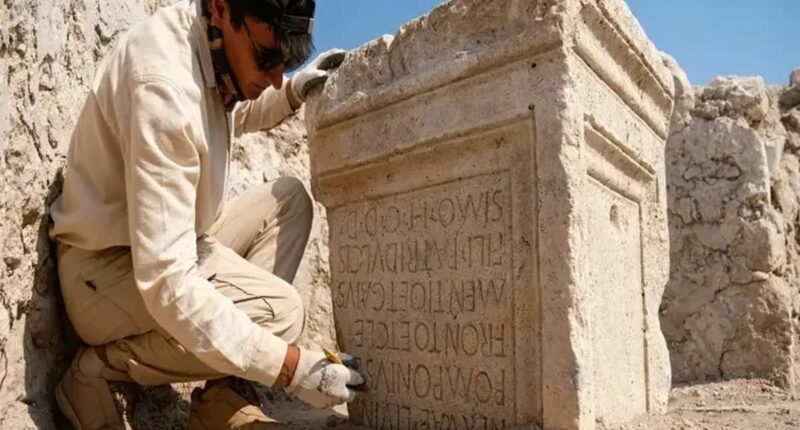Share this @internewscast.com
Archaeologists have made a stunning discovery at a biblical city where the Apostle Paul famously performed a miraculous healing of a man born lame.
Teams working in the ancient city of Lystra have uncovered a 100-foot-long basilica adorned with gold-gilded mosaics and richly decorated walls, hallmarks of late antique craftsmanship.
The basilica provides tangible evidence that Lystra was a thriving urban center during the earliest centuries of Christianity.
The discovery confirms biblical accounts by showing that Lystra was a real, organized Christian community, large enough to support worship, leadership structures, and the activities described in the Acts of the Apostles, including Paul’s healing miracles and the appointment of Timothy as a church leader.
Its location near modern-day Hatunsaray in central Anatolia also aligns with the geographic details mentioned in scripture, reinforcing the historical accuracy of the biblical narrative.
Although Lystra’s importance has long been recorded in the Bible, where it is mentioned eight times, the unearthing of this basilica provides concrete archaeological evidence of the city’s role in spreading Christianity across the region.
The basilica likely functioned as both a center of worship and an administrative hub, illustrating how early Christian church organization developed in Anatolia, particularly around Konya, known in ancient times as Iconium.
Archaeologists believe the find could be the clearest proof yet that stories once confined to scripture were grounded in the living cities and miracles of the ancient world.

The Bible says that apostles performed miracles in the ancient city of Lystra. Archaeologists have uncovered ruins of a church that support history in scripture
Established as a Roman colony under Emperor Augustus, Lystra rose to prominence as one of the leading cities in the ancient region of Lycaonia.
According to the New Testament, Paul and his companion Barnabas visited the city during their first-century missionary journeys.
Acts 14:8-10 reads: ‘In Lystra there sat a man who was lame. He had been that way from birth and had never walked. He listened to Paul as he was speaking.
‘Paul looked directly at him, saw that he had faith to be healed, and called out, ‘Stand up on your feet!’ At that, the man jumped up and began to walk.’
The miracle, according to the Bible, was witnessed by many locals who reportedly mistook Paul and Barnabas for the gods Hermes and Zeus.
Among other apostles connected to Lystra was Timothy, Paul’s ‘spiritual son,’ who is believed to have been appointed one of the first bishops in the region.
Acts 16:1–3 reads: ‘Paul came to Derbe and then to Lystra, where a disciple named Timothy lived, whose mother was Jewish and a believer but whose father was a Greek.
‘The believers at Lystra and Iconium spoke well of him. Paul wanted to take him along on the journey, so he circumcised him because of the Jews who lived in that area, for they all knew that his father was a Greek.’

Archaeologists uncovered stunning artifacts, including coins and turquoise-colored beads found in children’s graves, suggesting that the site retained spiritual importance well into the 12th to 13th centuries

The discovery confirms biblical accounts by showing that Lystra was a real, organized Christian community, large enough to support worship, leadership structures, and the activities described in the Acts of the Apostles
Excavations in the ancient city also revealed new insight into the Seljuk era, which was the period when the Seljuk Empire, a medieval Turkic dynasty, dominated a vast territory in Central and Western Asia from the 11th to the 13th centuries, with its greatest influence in Anatolia.
This era saw the significant introduction of Turkic culture and Islam to Anatolia, a flourishing of Persian culture and arts, and pivotal roles in conflicts like the Crusades.
Archaeologists uncovered stunning artifacts, including coins and turquoise-colored beads found in children’s graves, suggesting that the site retained spiritual importance well into the 12th to 13th centuries.
These beads are considered precursors to the nazar boncuğu (evil-eye bead), illustrating a period of cultural and religious coexistence between Christians and Seljuk Turks.
İlker Mete Mimiroğlu of Necmettin Erbakan University, who led the excavation, told ArkeoNews: ‘It shows that when the Seljuks came, the local Christian population did not disappear.

Lystra was founded by a Roman colony under Emperor Augustus, and archaeologists have uncovered ruins left behind
‘They continued their lives under Seljuk rule, within an atmosphere of tolerance.’
Parts of the basilica were repurposed into smaller chapels, with one altar incorporating a Roman funerary stele, highlighting how successive civilizations adapted the same sacred space for new purposes.
The discovery has provided a rare opportunity to connect biblical narratives to archaeological evidence, showing that Lystra was a historical city where early Christian faith and community thrived.
‘From the miracle of the lame man to the grand basilica and beyond, the city embodies centuries of devotion, artistry, and cultural exchange,’ said Mimiroğlu.








